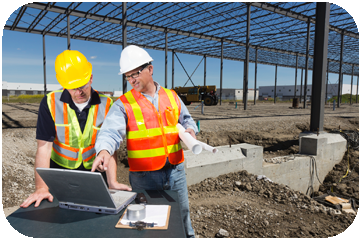Geotechnical Geologist Providers for Accurate Soil and Rock Evaluation
Geotechnical Geologist Providers for Accurate Soil and Rock Evaluation
Blog Article
Exactly How Consulting Engineers Enhance Geotechnical Engineering Projects: Insights Into Their Proficiency, Approaches, and Collaborative Approaches
Consulting designers are crucial in improving geotechnical engineering jobs, using their specialized knowledge to navigate the complexities of subsurface problems. Their collective strategies foster communication among diverse project stakeholders, ultimately forming the project's trajectory.
Function of Consulting Engineers
The experience of consulting engineers in geotechnical engineering is fundamental to the successful execution of building tasks. These professionals play a crucial function in assessing soil and rock properties, which are critical factors influencing layout and building decisions. By performing thorough site examinations, getting in touch with designers accumulate important data that educates the design procedure, guaranteeing projects are constructed on stable and ideal ground.
Consulting engineers likewise provide indispensable insights right into threat monitoring (geotechnical geologist). They recognize potential geotechnical risks, such as landslides, dirt liquefaction, and negotiation problems, allowing stakeholders to carry out efficient reduction approaches. Their expertise aids in optimizing foundation styles, which can cause substantial cost financial savings and improved safety
Additionally, getting in touch with designers act as an important link between task proprietors, designers, and service providers. Their ability to translate complicated geotechnical data right into actionable suggestions fosters partnership and promotes informed decision-making throughout the task lifecycle. This multidisciplinary method not only enhances task effectiveness but likewise makes certain compliance with governing criteria and best practices.
Trick Methods in Geotechnical Design

One main method is site examination, which involves carrying out field examinations and lab analyses to gather information on subsurface problems. Techniques such as Requirement Penetration Testing (SPT) and Cone Penetration Testing (CPT) are commonly utilized to review dirt stratigraphy and strength. Furthermore, geophysical approaches, consisting of seismic and electric resistivity studies, offer non-invasive methods to assess subsurface features.
One more critical technique is mathematical modeling, which makes it possible for designers to replicate different circumstances and predict exactly how soil-structure communications will act under various loading problems. Limited Aspect Evaluation (FEA) is a typical strategy used in this context.
Furthermore, the style of foundations, preserving frameworks, and earthworks relies greatly on these methodologies - geotechnical geologist. By incorporating sophisticated logical tools with field information, consulting engineers can establish customized remedies that address specific job obstacles, inevitably adding to the stability and safety of building and construction projects
Importance of Soil Evaluation
Dirt evaluation functions as a fundamental element in geotechnical design, providing crucial understandings right into the physical and chemical buildings of soil essential for reliable building preparation. Recognizing soil qualities is essential for identifying its load-bearing capability, drainage habits, and potential for negotiation or instability. In-depth dirt investigations, consisting of sampling and laboratory screening, help recognize criteria such as soil kind, dampness web content, density, and shear stamina.
These evaluations educate the choice of suitable building methods and products, description eventually affecting project safety and longevity. Natural dirts may call for various structure styles compared to granular soils, demanding customized design remedies. Furthermore, dirt analysis help in recognizing pollutants that might position dangers to human wellness or the atmosphere, permitting the growth of mitigation techniques.
Integrating dirt analysis into the onset of job development aids to lessen unforeseen difficulties, making certain that engineers can prepare for and attend to prospective problems prior to they escalate. By developing a detailed understanding of the website conditions, getting in touch with designers can optimize style effectiveness and reduce prices, thus improving the general success of geotechnical engineering projects.
Collective Techniques in Tasks
Effective geotechnical tasks commonly depend upon joint strategies that combine varied proficiency from various self-controls. Reliable cooperation among consulting engineers, rock hounds, ecological researchers, and construction experts is essential for dealing with intricate obstacles and enhancing project end results. By leveraging the special abilities and understanding of each staff member, projects can benefit from an alternative understanding of the website conditions, regulatory demands, and engineering constraints.
Regular communication and interdisciplinary conferences promote the sharing of understandings and promote a society of team effort. These collective check my reference efforts allow the recognition of potential risks early in the task lifecycle, enabling timely reduction methods. Including feedback from stakeholders, including local neighborhoods and regulative firms, guarantees that all perspectives are thought about, boosting project approval and conformity.
In addition, the integration of innovative technologies, such as Geographic Information Solution (GIS) and Building Info Modeling (BIM), further enhances partnership. These tools permit for the real-time sharing of data and visualization of geotechnical conditions, advertising notified decision-making. Eventually, a collaborative technique not only improves task execution yet also lays the foundation for innovative remedies to complex geotechnical engineering difficulties.
Influence On Task End Results

Consulting designers employ sophisticated methodologies such as danger assessment and predictive modeling, which enhance the accuracy of task projections. Their ability to integrate innovative modern technologies, like geotechnical instrumentation and data analytics, even more fine-tunes the design and building processes. Because of this, projects experience enhanced effectiveness, reduced prices, and reduced delays.
Additionally, fostering effective interaction and partnership amongst employee enhances problem-solving abilities. When obstacles occur, a united front enables swift identification of options, preventing prospective problems. Ultimately, the collaborative efforts of speaking with designers add to higher quality results, ensuring that tasks fulfill both regulatory criteria and customer expectations.
Verdict

Report this page